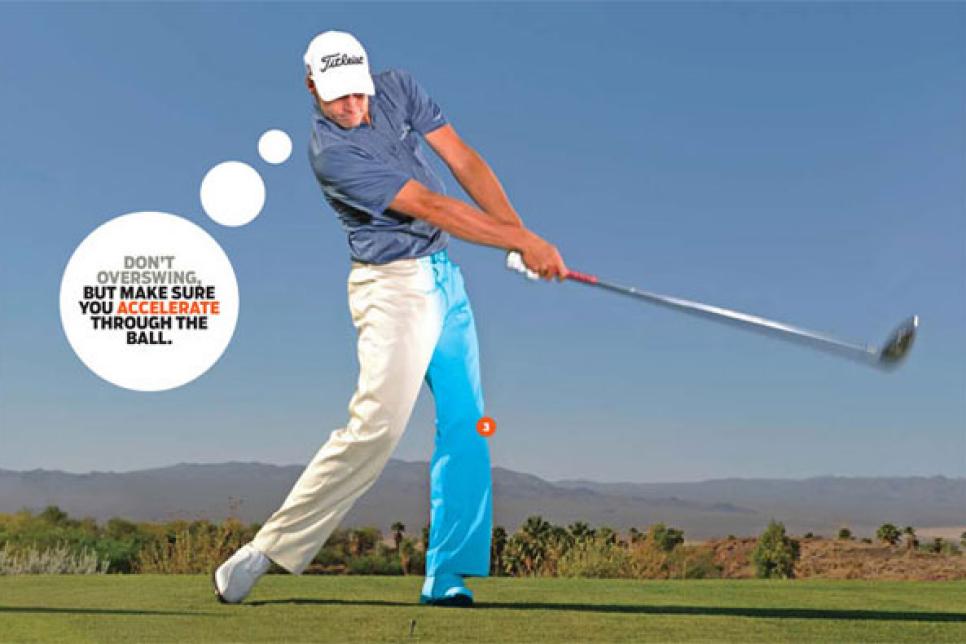Driving
Nick Watney's Power Pointers

You probably heard about one of my students, Nick Watney, when he won the PGA Tour's Buick Invitational last year and then finished second at Doral (WGC-CA Championship). Nick has come a long way as a player in the last couple of years, and a big reason for his success is the way he's swinging the driver. When Nick was in college at Fresno State and even after he turned pro seven years ago, he was a very handsy player. Because he had such great rhythm, when he timed everything just right, he played pretty well. But when his timing was off, he would struggle. He needed better swing mechanics, and that's what we've been working on. Here Nick and I will share with you some of the reasons he has improved so much off the tee, because we think the advice can really help you, too. First, Nick will demonstrate why he's one of the best drivers on tour. Then, I'll show you a few drills so you can learn to swing it like he does.


1. CREATE MORE WIDTH
When Nick came to me, his hands were too active on the backswing, which made his swing arc narrow--a big killer of distance. The club got too far to the inside, so he would shift his weight away from the target on the downswing to get the club back in position to hit the ball.
I wanted Nick to feel his arms staying in front of his body as he turned back. We worked hard on building a backswing where his right arm and hand were as far away from his head at the top as possible. This gave Nick, who is 6-feet-2, tremendous width in his swing arc.
DRILL: Swing Outside The Stakes
To improve the width of your swing, put two stakes in the ground on either side of your address position, just inside the target line (inset). They should lean at an angle matching your clubshaft at address. Now make swings where the club stays in front of the shafts. Feel how your arms stay in front of your body?
2. SHIFT YOUR WEIGHT

Nick had to fight a tendency to let his weight shift to the outside of his right foot during the backswing. Now he braces beautifully over his right leg, creating a great coil. This move helped shorten his swing--better for accuracy--but it also increased his clubhead speed.
It's true, you always want your body weight moving in the same direction the club is moving, but your weight needs to stay between your feet for efficient power. If you sway too far to the right, it becomes hard to stay in balance and shift back to the left.
DRILL: Keep your knee flexed
The key to making a proper shift into your right leg as you swing back is to maintain some flex in your right knee. It will help prevent you from overshifting. Keeping the knee flexed also will put you in a tighter body coil at the top, so you can fire into the ball with more speed. It's like loading and releasing a spring.


3. GET TO YOUR LEFT SIDE
The most common fault among amateurs is, they don't transfer their weight to their front foot when they start the downswing. Nick had a little bit of this "hang back" move in his swing. It was a result of being too narrow on the backswing, and then trying to create room for the club to swing into the ball. He had a reverse-C body position through the ball.
Amateurs tend to rush the transition from backswing to downswing, which leads to releasing the club too early and hitting with too much weight still on the back foot.
DRILL: Practice downhill
The best way to ingrain the proper shift is to hit shots off a downhill lie. Swinging down a slope promotes the forward weight transfer. Your contact will tell you how you're doing. If you don't shift enough, you won't hit it solid. If you shift too much, you'll fall forward. To catch it flush, you have to make a smooth shift.

HOW YOU LOSE POWER
__1. NARROW SWING ARC:__If you take the club back too far inside the target line or with your hands and arms only, the result will be a narrow swing arc and reduced speed.
2. LOSS OF KNEE FLEX: Straightening your right knee during the backswing can lead to shifting too far away from the target. From there, it's very hard to move toward the target effectively when you swing down.
3. POOR WEIGHT SHIFT: Even if you shift your weight properly during the backswing, you still have to move forward aggressively on the downswing. Get off that right side!